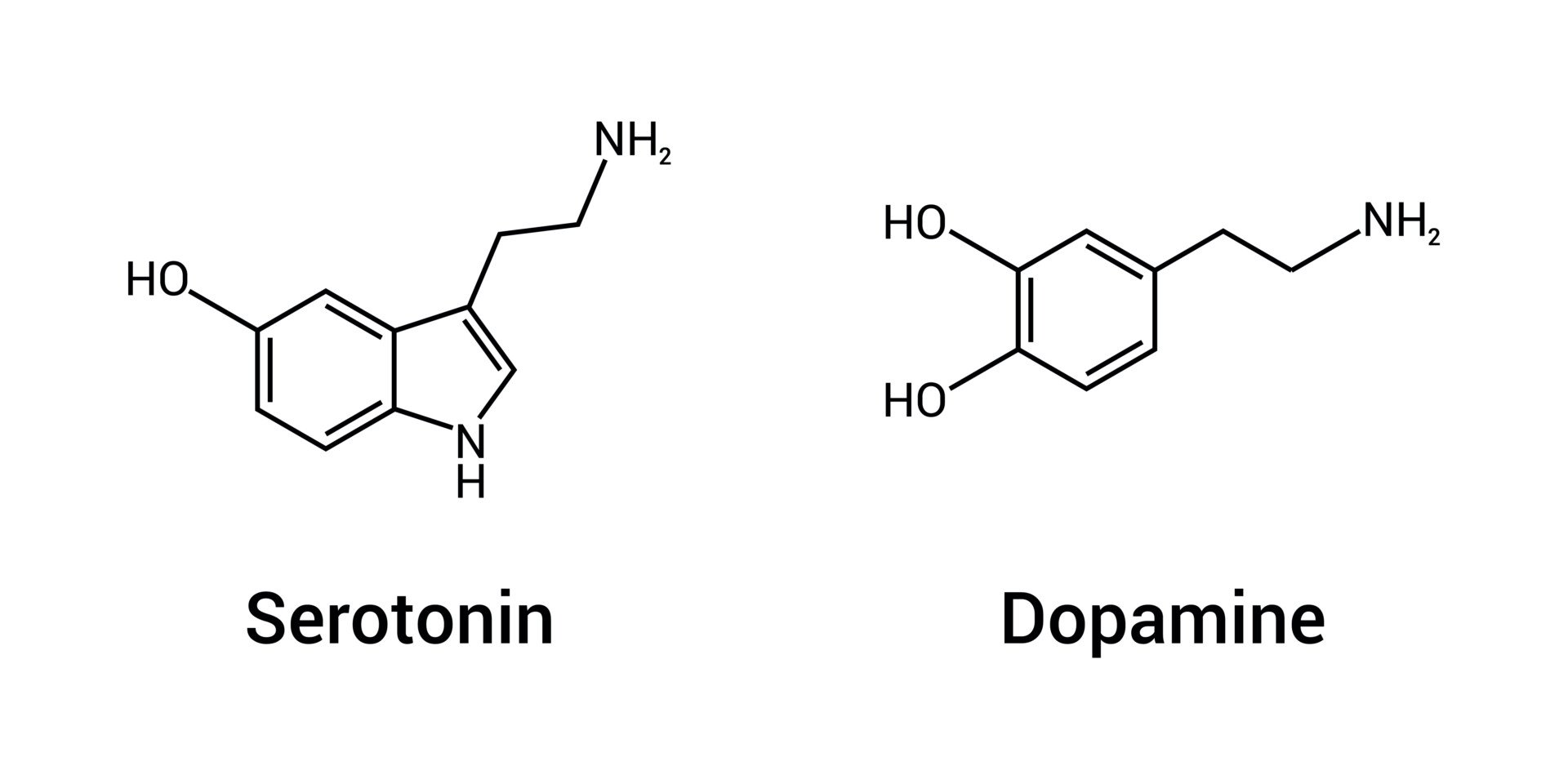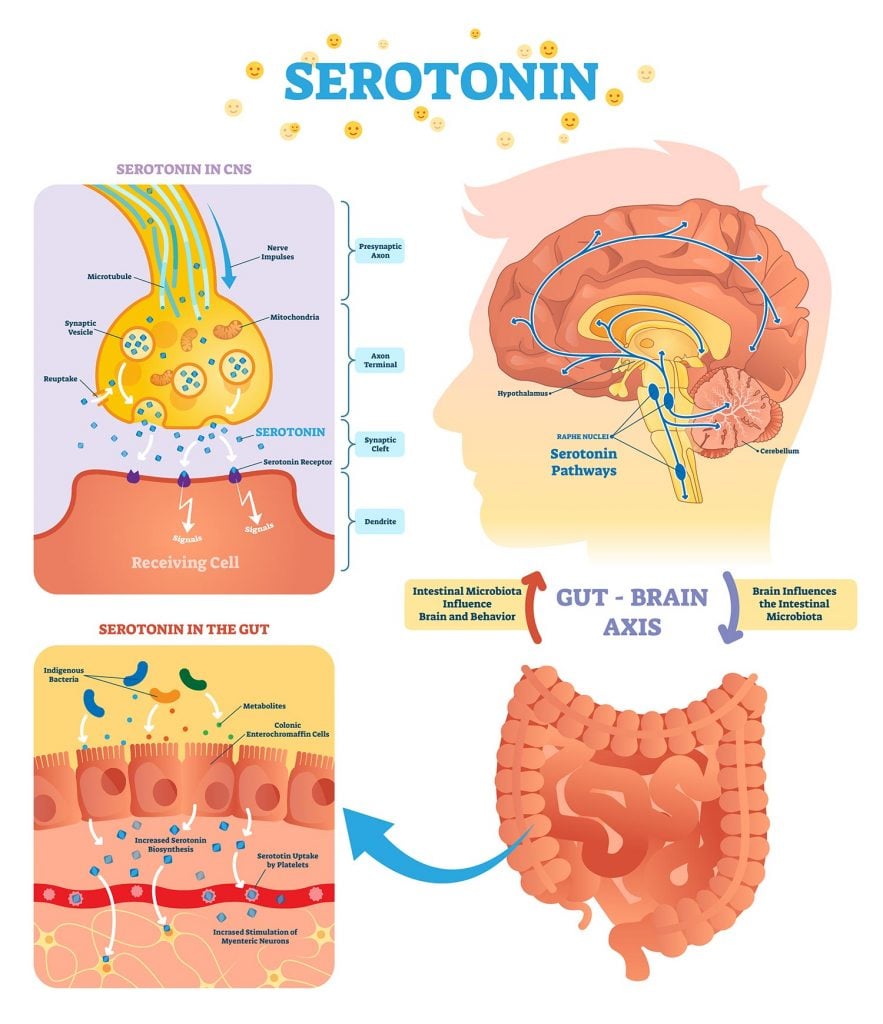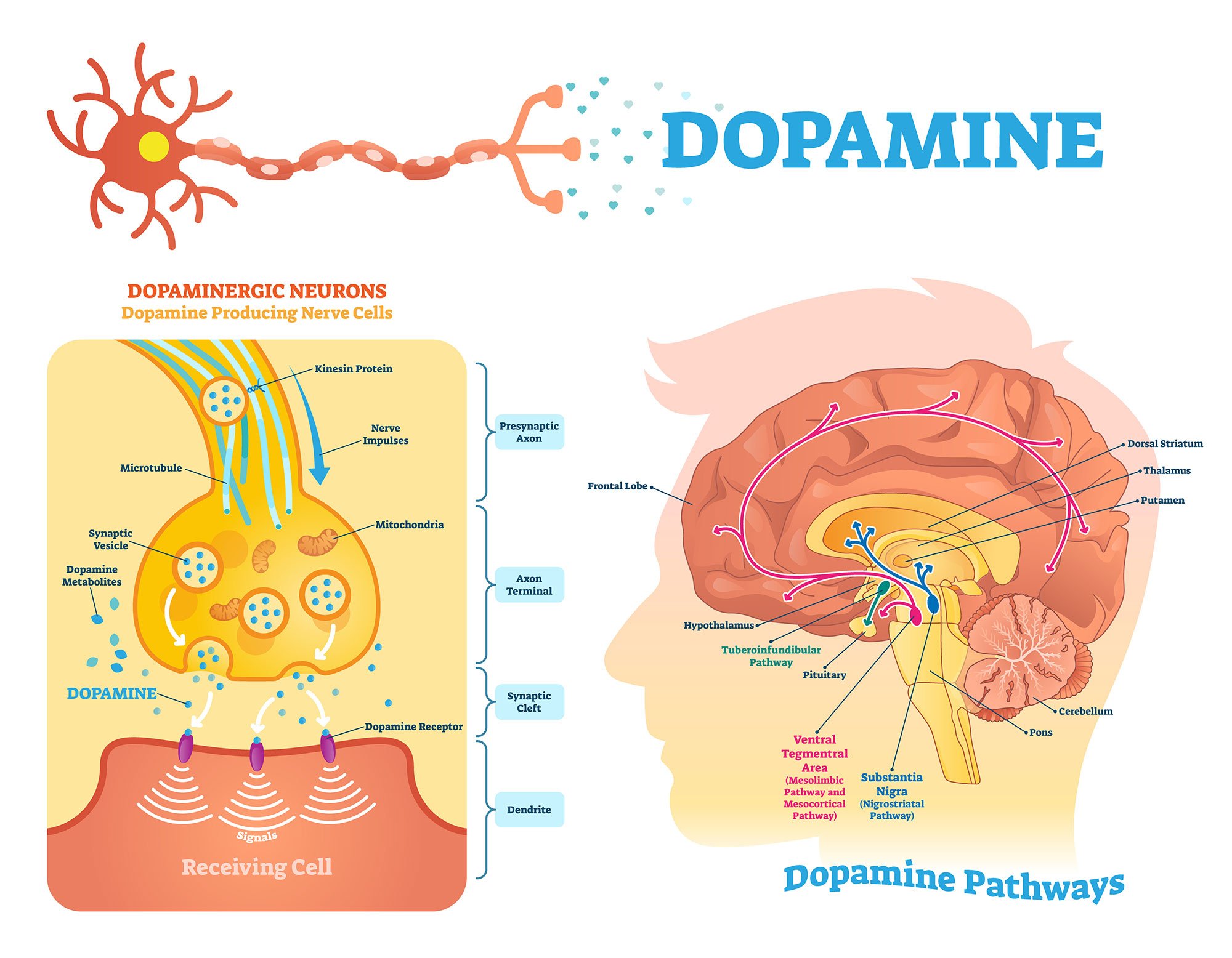On This Page:
Serotonin and dopamine are neurotransmitters that play vital roles in regulating mood, motivation, and other bodily functions. Serotonin is often associated with mood regulation, appetite, sleep, and feelings of well-being. Dopamine, on the other hand, is linked to pleasure, reward, motivation, and movement. While both influence mood and emotion, their specific functions and pathways in the brain differ considerably.
Key Takeaways
- Dopamine and serotonin are both neurotransmitters, meaning they are chemical messengers in the brain that communicate via neurons.
- Serotonin is associated with feelings of happiness, focus, and calm, whilst dopamine is associated with feelings of rewards, motivation, and productivity. Dopamine and serotonin are considered the ‘happy hormones’ as they increase positive moods and emotions.
- Both dopamine and serotonin also play a role in regulating digestion by suppressing or increasing appetite, depending on the body’s needs.
- Whilst they have similar effects on the brain and body, they work in different ways. A lack of either of these chemicals, or both, has been linked with mental health conditions, especially mood disorders, and addiction.

| Serotonin | Dopamine |
|---|---|
| An inhibitory neurotransmitter | An excitatory neurotransmitter |
| Regulate Mood | Regulate Motivation |
| Associated with feelings of happiness, focus, and calm | Associated with feelings of rewards, motivation, and being productive |
| Contributes to sleep and digestion | Important for normal movement and balance |
| Deficiency is linked with sensitivity to pain, aggressiveness, anxiety, and depression. | Deficiency is linked with sensitivity to memory loss, low sex drive, poor digestion, and poor cognition. |
Table: Serotonin vs. dopamine
What is Serotonin?
Serotonin is a neurotransmitter, a chemical messenger which is produced in the central nervous system (CNS). Serotonin is given the scientific name 5-hydroxytrytamine (5-HT) and is a neurotransmitter of the monoamine group, which contains amino acids. Serotonin is of interest to psychologists because of its role in mood.
This neurotransmitter is essential for feeling happiness, and low serotonin levels are therefore related specifically to mood disorders such as depression.
What does serotonin do?
Serotonin can also affect many aspects of behavior, such as in memory, attention, reward, and anger. It can also have a role in sleep as it stimulates the parts of the brain which control sleep and wakefulness.

Outside of the brain, serotonin works as a hormone within the enteric nervous system, specifically found in the gastrointestinal tract. Its role in the enteric nervous system is to promote healthy digestion, control heart rate, and heal wounds, among other functions.
Within the brain, serotonin is mostly produced in the brain stem, within a cluster of nuclei called the Raphe nuclei. Serotonergic fibers are then produced from the Raphe nuclei and projected to the nucleus accumbens, an area of the brain that works as a circuit area for rewards.
Once at the nucleus accumbens, serotonin is then projected throughout the brain to multiple brain regions, including the lobes of the brain, cerebellum, hippocampus, and spinal cord.
Serotonin is classified as an inhibitory neurotransmitter, meaning it decreases the likelihood that the neurons will fire an action potential. Therefore, serotonin does not stimulate the brain. Instead, it balances out any excessive excitatory effects of other neurotransmitters.
During neurotransmission, serotonin is released into the synaptic cleft, a gap between the presynaptic neuron and the postsynaptic neuron.
Once here, the serotonin will either reach the serotonin receptor on the postsynaptic neuron and continue down the next neuron via electrical impulses, or serotonin will be broken down by an enzyme called monoamine oxidase or the serotonin will be reabsorbed back into the presynaptic neuron by a serotonin transporter.
What is Dopamine?
Dopamine is also a neurotransmitter found in the CNS, which, like serotonin, is a monoamine neurotransmitter, meaning it is derived from amino acids. Dopamine is both an excitatory and inhibitory neurotransmitter and therefore has various effects.
Dopamine is primarily associated with feelings of pleasure, such as the satisfaction someone may feel from achieving a goal. It is also involved in feelings of motivation, sleep, attention, and memory and is important in movement.

A reward system is involved in dopamine, which helps to incite a positive mood and heighten motivation.
What does dopamine do?
During neurotransmission, dopamine is released from the presynaptic neuron to reach the dopamine receptors on the postsynaptic neuron.
Dopamine is highly concentrated in areas of the brain called the substantia nigra and the ventral tegmental area (VTA) in the midbrain. In other brain areas, dopamine can be made in the hypothalamus and the olfactory bulb.
There are dopamine pathways that can be triggered when exposed to a rewarding stimulus, resulting in increased amounts of dopamine circulating around brain areas.
Once produced in the VTA, dopamine can be transported through these pathways, two of the main ones being the mesolimbic and the mesocorticol pathways. For the mesolimbic pathway, dopamine gets activated in the VTA, which is then projected to the nucleus accumbens, an area that is major in the brain’s reward circuit.
Once at the nucleus accumbens, dopamine levels here rise and then can be projected to the limbic system, specifically the amygdala and the hippocampus.
Connections to the amygdala can contribute to feelings associated with the reward. Connections to the hippocampus can help to attribute memory and learning to the reward. Connections to both areas encourage the repetition of the rewarding experience or behavior.
For instance, when eating a tasty food, pathways to the amygdala will associate positive feelings towards this food whilst the pathways to the hippocampus will help to remember the positive feelings towards the food, making it more likely that this food will be sought out again.
For the mesocorticol dopamine pathway, dopamine also gets activated in the VTA, but instead has direct connections to the cerebral cortex, primarily the frontal lobes.
The frontal lobes are linked with high cognitive functions and so this area will encourage conscious experience of the pleasure and reward being experienced. This can attribute attention and motivation to the rewarding experience.
Do Serotonin and Dopamine Work Together?
Although serotonin and dopamine work differently and differ in function, neurotransmitters interact with each other in some way.
Serotonin and dopamine interact with each other to maintain a chemical balance in the body.
Serotonin and dopamine have opposite effects on appetite. Whilst serotonin suppresses it, low levels of dopamine can stimulate hunger.
In anatomical studies, it has been found that dopaminergic neuronal bodies and terminals are modulated by serotonin, and they receive rich projections from serotonin neurons. These strong neuronal connections seem to promote the functional modulation of serotonin over dopaminergic activities in the neural network.
For instance, a serotonin receptor named 5HT2 seems to inhibit dopaminergic activity, whereas the 5HT2 receptor antagonists counteract the inhibition of dopaminergic activity.
Interactions between serotonin and dopamine could provide the framework for understanding the mechanisms behind some of the impulsive aggressive behaviors displayed in people.
Since serotonin is thought to have functional regulation over dopaminergic systems, deficiencies in serotonin functions may result in hyperactivity of the dopamine system, promoting impulsive behavior.
This relationship may account for some of the serotonin and dopamine dysfunctions in those with impulsive aggression. This is supported by studies on rats.
It was found that after a fight, the rats had markedly decreased serotonin levels but significantly increased dopamine levels. This could imply that decreased activity of serotonin in aggression is linked with increased dopamine activity.
The Role of Serotonin and Dopamine in Depression
Depression is a key mental health condition of interest to those interested in serotonin and dopamine. It is believed each neurotransmitter may play a role in the development of depressive disorders.
Although dopamine alone may not directly cause depression, low levels of dopamine have been suggested to cause specific symptoms associated with depression:
- Lack a motivation
- Difficulty concentrating
- Feeling hopeless
- Feeling helpless
- Loss of interest in previously enjoyed activities
It is implied that these symptoms may be linked to a dysfunction in the dopamine systems of the brain. A main trigger for these dysfunctions may be due to stress, pain, or trauma.
A physiological explanation is that there may be a diminished dopamine release from the presynaptic neurons and/or impairment in signal transduction, possibly due to changes in the number of dopamine receptors.
Whilst dopamine may be linked to experiencing certain symptoms of depression, serotonin seems to be more involved in how emotions are processing, which can affect the overall mood of an individual.
A possible explanation of depression in relation to serotonin is that there may not be enough serotonin being produced in the Raphe nuclei.
Another is that the serotonin receptors on the postsynaptic neuron are not working properly, meaning that serotonin cannot bind to them.
Also, once released into the synaptic cleft, the monoamine oxidase enzyme may be breaking down too much of the serotonin, or serotonin is being reabsorbed back into the presynaptic neuron.
Any of these dysfunctions can cause a lack of serotonin in the brain and ultimately affect mood.
Conditions Associated with Serotonin
If someone has abnormalities in their levels of serotonin, they may experience one or more of the following symptoms:
- Low mood
- Anxiety
- Aggression
- Low self-esteem
- Irritability
- Memory problems
- Poor appetite
- Sleep problems
- Impulsivity
Serotonin is thought to be involved in conditions relating to anxiety. Studies suggest specifically that social anxiety disorder (SAD) is associated with reduced serotonin binding to the receptors of the postsynaptic neurons.
However, it has also been suggested that neurotransmission in SAD is characterized by an overactive presynaptic serotonin system (Frick et al., 2015).
Obsessive-compulsive disorder (OCD) is another anxiety disorder that may also be explained somewhat by serotonin deficiencies, especially the symptoms of OCD surrounding intrusive anxious thoughts.
People with OCD have also been found to have low serotonin binding to receptors. People who are diagnosed with schizophrenia may also have low serotonin levels.
Individuals with this condition may experience unusual thoughts which are not grounded in reality and develop delusions as a result.
Serotonin syndrome is a condition that can occur when there is too much serotonin in the body, usually as a result of taking a high dosage of medications that aim to increase low serotonin levels.
Some symptoms of serotonin syndrome include high heart rate, restlessness, and headaches, but it can result in seizures, unconsciousness, or death in rare cases if not treated.
Conditions Associated with Dopamine
If someone has abnormalities in the neurotransmitter dopamine, they may experience one or more of the following symptoms:
- Aches and pains
- Muscle cramps
- Weight loss or weight gain
- Loss of balance
- Fatigue
- Low energy
- Low self-esteem
- Disturbed sleep
- Feeling demotivated
- Inability to focus
- Mood swings
- Delusions
- Hallucinations
A common condition that is believed to be associated with dopamine is schizophrenia. In schizophrenia, the positive symptoms of hallucinations and delusions are thought to be linked to high dopamine levels.
It has been found that dopamine abnormalities in the mesolimbic and prefrontal areas of the brain exist in those with schizophrenia. The dopamine systems in these areas become overactive and can therefore lead to the experience of hallucinations and delusions.
Another condition that has shown links to dopamine levels is Parkinson’s disease. As dopamine can play a role in sending messages to parts of the brain that control movement and coordination, low dopamine levels can cause disruptions in movement and may ultimately be a cause of movement disorders such as Parkinson’s disease.
Substance use disorder is also a condition that can affect dopamine levels as it can alter the threshold for dopamine activation and signaling. As someone continues to use a drug that causes a ‘high’ of dopamine levels, the threshold for achieving this high increases.
This means it will become increasingly difficult for someone to experience the positive effects of dopamine without resulting in over-using the drug.
Individuals who abuse drugs have been found to have significant decreases in the D2 dopamine receptors as well as a decrease in dopamine release, meaning they may not feel much pleasure from activities they would have felt pleasure from before taking drugs.
Summary
Dopamine and serotonin are essential neurotransmitters that produce similar feelings, especially those related to happiness and good moods. They appear to work together to balance out different bodily effects, as well as being able to inhibit each other.
Whilst producing similar feelings, they produce different effects. Dopamine is primarily related to reward and motivation, while serotonin is primarily involved in happiness and mood.
An imbalance of either of these neurotransmitters, either too much or too little, can have detrimental effects on the body, especially when it comes to mental health.
Whilst these neurotransmitters may not be the direct cause of mental health conditions such as depression, they both appear to have some contribution to mental health and our overall happiness.
References
Dunlop, B. W., & Nemeroff, C. B. (2007). The role of dopamine in the pathophysiology of depression. Archives of General Psychiatry, 64 (3), 327-337.
Eske, J. (2019, August 19). Dopamine and serotonin: Brain chemicals explained. Medical News Today. https://www.medicalnewstoday.com/articles/326090
Frick, A., Åhs, F., Engman, J., Jonasson, M., Alaie, I., Björkstrand, J., Frans, Ö., Faria, V., Linnman, C., Appel, L., Wahlsfedt, K., Lubberink, M., Fredrikson, M. & Furmark, T. (2015). Serotonin synthesis and reuptake in social anxiety disorder: a positron emission tomography study. JAMA Psychiatry, 72 (8), 794-802.
Juarez Olguin, H., Calderon Guzman, D., Hernandez Garcia, E., & Barragan Mejia, G. (2016). The role of dopamine and its dysfunction as a consequence of oxidative stress. Oxidative medicine and cellular longevity, 2016.
Lin, S. H., Lee, L. T., & Yang, Y. K. (2014). Serotonin and mental disorders: a concise review on molecular neuroimaging evidence. Clinical Psychopharmacology and Neuroscience, 12 (3), 196.
Seo, D., Patrick, C. J., & Kennealy, P. J. (2008). Role of serotonin and dopamine system interactions in the neurobiology of impulsive aggression and its comorbidity with other clinical disorders. Aggression and Violent Behavior, 13 (5), 383-395.
Vandergriendt, C. (2020, July 16). What the Difference Between Dopamine and Serotonin? Healthline. https://www.healthline.com/health/dopamine-vs-serotonin

